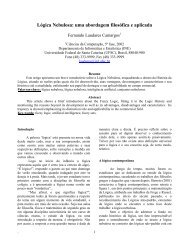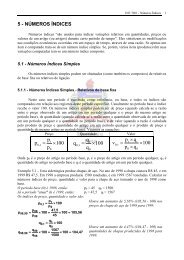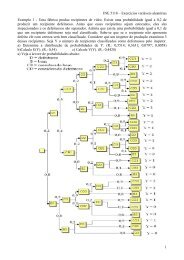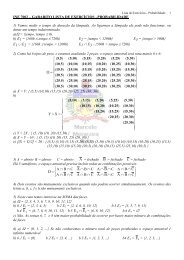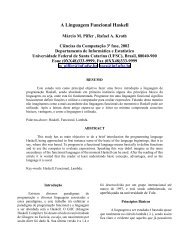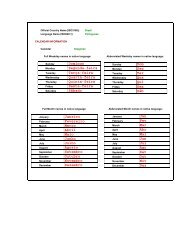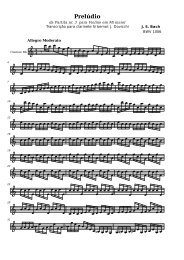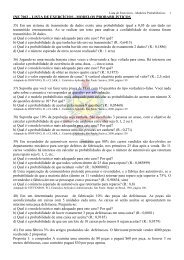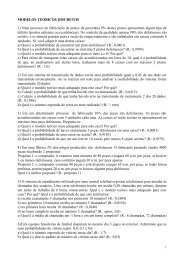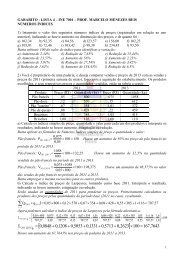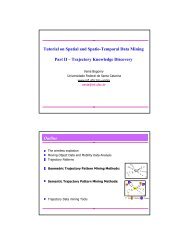Anais do IHC'2001 - Departamento de Informática e Estatística - UFSC
Anais do IHC'2001 - Departamento de Informática e Estatística - UFSC
Anais do IHC'2001 - Departamento de Informática e Estatística - UFSC
You also want an ePaper? Increase the reach of your titles
YUMPU automatically turns print PDFs into web optimized ePapers that Google loves.
<strong>Anais</strong> <strong>do</strong> IHC’2001 - IV Workshop sobre Fatores Humanos em Sistemas Computacionais 229<br />
Semiotic Consi<strong>de</strong>rations on Direct Concept Manipulation as a<br />
Distinct Interface Style for Learnware<br />
Clarisse Sieckenius <strong>de</strong> Souza 1<br />
, Kamran Sedig 2<br />
1 <strong>Departamento</strong> <strong>de</strong> <strong>Informática</strong>, PUC-Rio<br />
Rua Marquês <strong>de</strong> São Vicente, 225<br />
22453-900 - Rio <strong>de</strong> Janeiro, RJ – BRAZIL<br />
Information and Media Studies & Computer Science<br />
The University of Western Ontario<br />
Middlesex College, Rm 360<br />
Lon<strong>do</strong>n, Ontario, CANADA, N6A 5B7<br />
clarisse@inf.puc-rio.br, sedig@uwo.ca<br />
Abstract. Although direct manipulation (DM) has been consi<strong>de</strong>red a potentially<br />
inappropriate interface style for learnware, convincing indication that the<br />
problem with DM lies rather on “what is manipulated” than on the<br />
“manipulation” itself has been obtained from empirical studies in the <strong>do</strong>main of<br />
Eucli<strong>de</strong>an geometry. A semiotic examination of such findings suggests that there<br />
may be theoretically-based constraints on the kinds of visualizations that yield<br />
appropriate direct concept manipulation interfaces for learnware.<br />
Introduction<br />
Previous research about interface styles for learnware has suggested that direct<br />
manipulation (DM) is a potentially inappropriate <strong>de</strong>sign choice in this case, because ease of<br />
use and low cognitive effort may not be effective for learning purposes [Golightly, 1996;<br />
Golightly et al., 1996; Golightly & Gilmore, 1997; Holst, 1996; Rappin et al. 1997].<br />
Convincing indication that the problem with DM lies rather on what is manipulated than on<br />
the manipulation itself has appeared in empirical studies carried out with apprentices using<br />
Super Tangrams © [Sedig et al., 2001] to learn and retain the knowledge involved in<br />
translation, rotation, and reflection of geometric objects. Direct Object Manipulation<br />
(DOM) has been shown to lead to a faulty un<strong>de</strong>rstanding of abstract general concepts in the<br />
<strong>do</strong>main of 2-dimensional transformations in Eucli<strong>de</strong>an geometry, whereas Direct Concept<br />
Manipulation (DCM) has led apprentices to learn the targeted concepts.<br />
The reification of abstract concepts as visual manipulable forms hinges on important<br />
semiotic issues. When it comes to <strong>de</strong>signing DCM interfaces for learnware, the availability<br />
of a general framework to gui<strong>de</strong> choices among visual icons, indices or symbols would<br />
possibly increase the quality of such applications and their effectiveness as educational<br />
tools. Nevertheless, practical <strong>de</strong>sign gui<strong>de</strong>lines and techniques can only emerge from a<br />
systematic and comprehensive analysis of visual communication co<strong>de</strong>s and their impact on<br />
learning.<br />
This paper is a first step in this direction. It presents a semiotic analysis of the Super<br />
Tangrams © interface style, whose dimensions are used to reinterpret results reported in<br />
research about diagrammatic reasoning [Stenning & In<strong>de</strong>r, 1995; Stenning & Oberlan<strong>de</strong>r,



